I don't like Gnome and I usually use KDE, but on a specific computer I have to use Gnome, and I noted that after switching to Ubuntu Maverick, icons on eclipse menus were not showing anymore.
I asked on some newsgroups with no luck, then on IRC I was pointed to this bug, which solved my issue :)
You need to enable icons in menus with gnome configuration. You find some ways to do that on that bug report, but I simply ran gconf-editor on the command line, and enabled that checkbox:
Now my icons in menus are back :)![]()
Monday, November 22, 2010
Eclipse icons in menus are not showing in Ubuntu Maverick Linux
Wednesday, October 13, 2010
Using Compiz in KDE 4
 I've been using KDE 4 for some time now, and I was pretty happy with its own desktop effects. However, lately, I started to notice that kwin and xorg process were taking some CPU usage, and with graphic cards such as Intel GMA and ATI, the effects were not so smooth (while in Gnome with compiz they were much better). So I decided to try and use compiz with KDE as well; here's my (positive) installation and configuration experience.
I've been using KDE 4 for some time now, and I was pretty happy with its own desktop effects. However, lately, I started to notice that kwin and xorg process were taking some CPU usage, and with graphic cards such as Intel GMA and ATI, the effects were not so smooth (while in Gnome with compiz they were much better). So I decided to try and use compiz with KDE as well; here's my (positive) installation and configuration experience.
First of all I installed all these packages
emerald libemeraldengine0 compiz compizconfig-settings-manager compiz-kde compiz-fusion-plugins-main compiz-fusion-plugins-extra fusion-iconThen you found the compiz-fusion application in my KDE menu, in System. Run it, and you can set some configuration options with that icon, in particular, you need to change the window decoration to emerald, and the window manager (to compiz). Then you must select reload window manager.
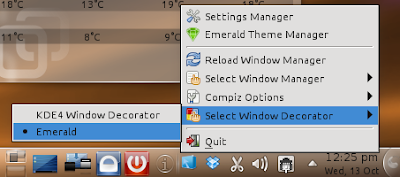
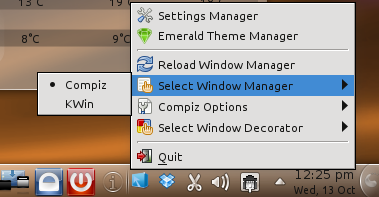
To keep compiz as the default window manager when KDE starts, you need to change System Settings -> Default Applications -> Window Manager (by selecting Compiz).
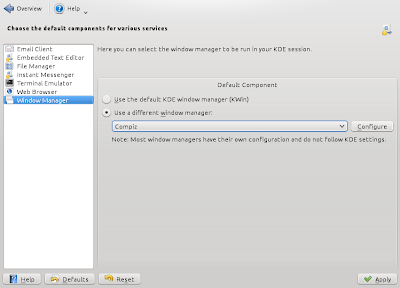
Of course, now you can configure compiz settings with its setting manager, but I suggest you to use the simpler configuration manager, simple-ccsm, as illustrated here.
Now enjoy compiz! :)
Pubblicato da
betto
a
12:08 PM
2
commenti
![]()
![]()
![]()
![]()
![]()
Tuesday, August 03, 2010
PhpBibliography 1.1.0
This new release of PhpBibliography features some nice features:
- First of all, themes are now supported so that the user can create his own theme (which will not be overwritten during phpbibliography updates), see this wiki page
- icons for known file extensions are shown for uploaded papers (see the screenshot)
- uploaded papers can be removed during editing
- the action menu was improved with tooltips
- search results can be shown also as bibtex
Pubblicato da
betto
a
4:32 PM
20
commenti
![]()
![]()
![]()
![]()
![]()
Etichette: phpbibliography
Wednesday, July 28, 2010
Merging Subtitles in Video Files with DivXConverter
I recently discovered this cool program, DivXConverter, which I didn't find in my Ubuntu distribution (you can download the .deb file, though, and install the required dependencies), but that's really useful and easy to use.
"DivX converter is a simple Mencoder frontend to Produce DivX Player Compatible AVI video format with the ability to merge subtitles . It support many video and audio filters and many presets."Now, the interesting features I've just used is the ability of merging a subtitle file (typically .srt) into a corresponding AVI file.
Here's what to do (see also the following screenshot):
- Add the avi file (and select the output folder and the compression, I left the default Normal compression)
- Make sure to select Xvid in the "Video Filters" tab to make sure the resulting avi is compatible with dvd/divx readers (at least the with ones I own)
- You can leave the default settings for Audio
- Select the subtitle file (I set ASCII as the encoding)
- Go back to the main window
- Press "Convert" and enjoy the resulting AVI file
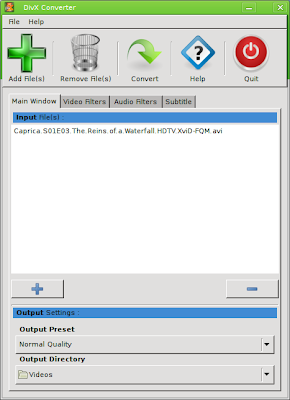
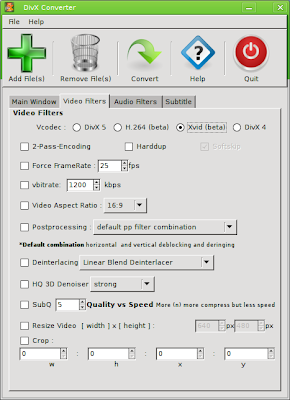
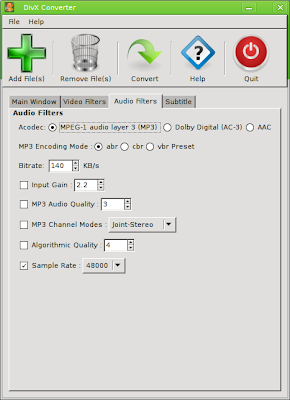


Pubblicato da
betto
a
5:19 PM
0
commenti
![]()
![]()
![]()
![]()
![]()
Friday, July 09, 2010
mounting none on /dev failed: No such device
If you're experiencing this error message at boot in Linux (e.g., after you recompiled the kernel in Ubuntu Lucid)
mounting none on /dev failed: No such device
don't be scared, the boot will continue and there'll be no problem (at least, I read in some posts); I never experienced problems even with this error at boot.
But if you want to get rid of it, just make sure that you have
CONFIG_DEVTMPFS=y
in your .config file of your kernel source directory.
Pubblicato da
betto
a
3:00 PM
3
commenti
![]()
![]()
![]()
![]()
![]()
Wednesday, July 07, 2010
mSoma a Qt client for SomaFM
 Andrea Grandi proposed me a few weeks ago to try and develop a client for SomaFM, a streaming radio with near 16 different channels, available for free. Indeed we wanted to try to develop an application for our cool Nokia N900 smartphone. Since this phone is now based on my beloved Qt framework, I accepted with much pleasure.
Andrea Grandi proposed me a few weeks ago to try and develop a client for SomaFM, a streaming radio with near 16 different channels, available for free. Indeed we wanted to try to develop an application for our cool Nokia N900 smartphone. Since this phone is now based on my beloved Qt framework, I accepted with much pleasure.
The really cool thing was that, by relying on the qt-mobility APIs (new Qt APIs for mobile application developers), we could enjoy cross-platform developing: all the code that I wrote for this player was tested and debuged on my computer, as a desktop application. Then, we deployed on the Nokia N900 and tried it there (and it worked seamlessly).
For instance, this are some screenshots of msoma running as a desktop application (in Linux in this case):

Of course, this is the very first version of this application, and surely the UI should be different in the desktop application with respect to the cellphone version (in order to be more usable in the mobile devices). But, as it is, it's already enjoyable (but I may be biased ;)
Source code is available on Gitorious and it's always updated with latest version we're working on. If someone want to test the application, it's available in extras-devel repository ("msoma" under Multimedia section) of N900.
In case you want to use it as a desktop application, please remember that you need qt-mobility. I blogged about the installation of qt-mobility in Linux.
We really want to thank, Rusty Hodge, SomaFM's founder, who provided so many details about SomaFM for developing our application (and of course we thank him also for SomaFM itself :)
We look forward to receiving feedback, patches, suggestions, and help! :)
Our maemo profiles:
Pubblicato da
betto
a
10:12 AM
1 commenti
![]()
![]()
![]()
![]()
![]()
Etichette: maemo, msoma, my programs, n900, nokia, qt, qt-mobility
Friday, June 18, 2010
Building Qt-Mobility in Ubuntu
Lately I started to try to develop applications for the Nokia N900, and the Maemo platform uses my beloved framework Qt :)
In particular, Nokia started to develop the Qt-Mobility Framework. Quoting from their white paper:
The Qt Mobility Project presents a collection of related software frameworks and interfaces. The objective being to deliver new Qt APIs for mobile application developers. Using these new APIs, developers will be able to create cross-platform applications targeting Maemo, Symbian and other platforms. This suite of features also has components that will be desirable to all users, not just those with mobile devices, so Mobility has advantages even for the desktop user.Thus, I wanted to try this project also on my Desktop (after all the intent of this framework is cross-platform development), and tried to compile qt-mobility on my Ubuntu/Kubuntu desktop. Unfortunately, I experienced many problems which now I seem to have solved, thus I'd like to share the steps to build qt-mobility from sources.
First of all, when installing qt-mobility after compilation, some files will be created in your current Qt installation. Thus, since I wouldn't want to spoil my qt installation from ubuntu packages, which is installed in system path, I downloaded the new qt framework 4.6.3 from the Nokia download site, and installed it in a path of my home: ~/usr/local/Trolltech/qtsdk-2010.03.
Then, I installed some packages that are useful to build qt-mobility and to enjoy media contents such as mp3 and videos, relying on gstreamer (not all these packages may be necessary, but after some tests, at least these packages will make things work):
sudo apt-get install libasound2-dev libbluetooth-dev libgstreamer0.10-dev libgstreamer-plugins-base0.10-dev network-manager-dev libxv-dev gstreamer-tools gstreamer0.10-plugins-base gstreamer0.10-ffmpeg w32codecs ubuntu-restricted-extras gstreamer0.10-plugins-good freeglut3-devThen, you need to get the sources of qt-mobility, and I got them from the git repository
git clone git://gitorious.org/qt-mobility/qt-mobility.git
However, you may want to get the stable sources (e.g., from qt-mobility download).
Since I'm a big fan of "shadow builds" which won't spoil your source directory, I built qt-mobility in another directory of my home, separate from the directory where I have the sources of qt-mobility (in this example the sources are in ~/install/qt-mobility): ~/build/qt-mobility/qt-4.6.3 (I specified the qt version I'm building qt-mobility with, since I may want to experiment with different qt versions):
- cd ~/build/qt-mobility/qt-4.6.3
- PATH=~/usr/local/Trolltech/qtsdk-2010.03/qt/bin:$PATH ~/install/qt-mobility/configure -examples -prefix ~/usr/local/Trolltech/qt-mobility > output.txt
Once the configuration step is successful, you can start building qt-mobility and then install it:
- make
- make install
- install -m 644 -p /home/bettini/build/qt-mobility/qt-4.6.3/features/mobility.prf /home/bettini/usr/local/Trolltech/qtsdk-2010.03/qt/mkspecs/features/
- install -m 644 -p /home/bettini/build/qt-mobility/qt-4.6.3/features/mobilityconfig.prf /home/bettini/usr/local/Trolltech/qtsdk-2010.03/qt/mkspecs/features/
Now, you can test your qt-installation by running an example (which was built and installed), for instance the player demo or the weather demo:
- ~/usr/local/Trolltech/qt-mobility/bin/player
- ~/usr/local/Trolltech/qt-mobility/bin/weatherinfo_with_location
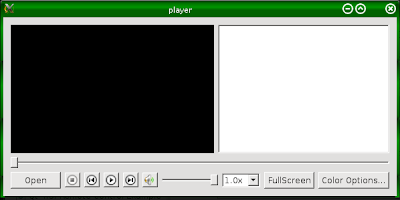

Now, let's try to see whether we're able to use qt-mobility in our programs.
We'll try to compile a very simple qt program using a class from the qt-mobility framework (QVideoWidget), though we won't do anything with that (just to see whether we can build the application).
here's the files of our project
myvideowidget.pro
QT += core gui |
#ifndef MAINWINDOW_H |
#include <QMediaPlayer> |
main.cpp
#include <QtGui/QApplication> |
now, you should run the qmake of your qt installation you've used to build qt-mobility, thus
- ~/usr/local/Trolltech/qtsdk-2010.03/qt/bin/qmake myvideowidget.pro
- g++ -c -pipe -O2 -Wall -W -D_REENTRANT -DQT_NO_DEBUG -DQT_OPENGL_LIB -DQT_GUI_LIB -DQT_NETWORK_LIB -DQT_CORE_LIB -DQT_SHARED -I../../../../usr/local/Trolltech/qtsdk-2010.03/qt/mkspecs/linux-g++ -I../../myvideowidget -I../../../../usr/local/Trolltech/qtsdk-2010.03/qt/include/QtCore -I../../../../usr/local/Trolltech/qtsdk-2010.03/qt/include/QtNetwork -I../../../../usr/local/Trolltech/qtsdk-2010.03/qt/include/QtGui -I../../../../usr/local/Trolltech/qtsdk-2010.03/qt/include/QtOpenGL -I../../../../usr/local/Trolltech/qtsdk-2010.03/qt/include -I/home/bettini/usr/local/Trolltech/qtsdk-2010.03/qt/include/QtMultimediaKit -I../../../../usr/local/Trolltech/qt-mobility/include -I../../../../usr/local/Trolltech/qt-mobility/include/QtMultimediaKit -I/usr/X11R6/include -I. -I../../myvideowidget -I. -o mainwindow.o ../../myvideowidget/mainwindow.cpp
- g++ -Wl,-O1 -Wl,-rpath,/home/bettini/usr/local/Trolltech/qtsdk-2010.03/qt/lib -Wl,-rpath,/home/bettini/usr/local/Trolltech/qt-mobility/lib -o myvideowidget main.o mainwindow.o moc_mainwindow.o -L/home/bettini/usr/local/Trolltech/qtsdk-2010.03/qt/lib -L/usr/X11R6/lib -L/home/bettini/usr/local/Trolltech/qt-mobility/lib -lQtMultimediaKit -lQtOpenGL -L/home/bettini/usr/local/Trolltech/qtsdk-2010.03/qt/lib -L/usr/X11R6/lib -lQtGui -lQtNetwork -lQtCore -lGLU -lGL -lpthread
Pubblicato da
betto
a
11:05 AM
2
commenti
![]()
![]()
![]()
![]()
![]()
Etichette: kubuntu, maemo, qt, qt-mobility, ubuntu
Tuesday, May 11, 2010
Eclipse internal Web Browser in Ubuntu Lucid
After switching to Ubuntu Lucid I noted that in my eclipse php installation the internal web browser was not working anymore since it was lacking some mozilla libraries.
In that case, it is enough to install the current xulrunner:
sudo apt-get install xulrunner-1.9.2
and the internal web browser in eclipse will work again! :)

Pubblicato da
betto
a
9:14 PM
1 commenti
![]()
![]()
![]()
![]()
![]()
Wednesday, May 05, 2010
PhpBibliography 1.0 - using CakePhp
The brand new release of PhpBibliography is out!
PhpBibliography allows you to publish your bibliography online (and to edit it via web).
It is implemented in Php 5 and uses MySql 5 (however, it might work also with Php 4, and also with MySql 4, but I'm not testing this).
This is a complete rewriting using CakePhp, the old version site is available here.
CakePhp is really a wonderful framework and I really enjoyed using it for PhpBibliography.
Hopefully, PhpBibliography is now more stable, relying on many mechanisms offered by CakePhp, and it looks nicer (in my opinion at least).
In the near future, I'm also planning to allow customization of the look by relying on CakePhp themes.
If you have an already installed version of PhpBibliography (earlier than version 1.x) you will need to follow the instructions you find at this link.
PhpBibliography now comes with a web based installation procedure which should minimize the efforts of the user who installs it (hopefully).
These are the main features provided by PhpBibliography:
- Automatic generation of bibtex for papers (unless a manual bib item is specified when editing the paper).
- For each paper two files can be uploaded and two links can be specified.
- Papers can be searched with criteria about their fields.
- Besides standard fields, new attributes can be specified for papers; attributes can be selectable, i.e., the logged user can choose among a(n extensible) set of values and multiple, i.e., a paper can be given several values for that attribute; an example of selectable/single attribute is "Publisher", an example of selectable/multiple attribute is "Keyword", and an example of non-selectable attribute is "DOI".
- Papers can be specified as private (visible only to logged users).
- Reports can be generated by filtering by author, by value and by grouping up to two levels (e.g., show only papers of a given authors, grouped by year and by paper type).
- RSS feeds are available for search results, reports and paper lists.
- Lists of papers, and results of reports and searches can be included in other webpages (by using the bare layout).
- Papers can be imported from DBLP.
- Searches for possible duplicate papers.
- Papers can be inserted through bibtex items and bibtex files.
Pubblicato da
betto
a
6:18 PM
0
commenti
![]()
![]()
![]()
![]()
![]()
Etichette: cakephp, phpbibliography
Monday, May 03, 2010
Package php-doc missing in Ubuntu Lucid
After installing the new Ubuntu Lucid I discovered that the package php-doc is not available anymore. Since I often work offline, having the php documentation installed to be browsed offline is a must for me.
It looks like for the moment that package is not available due to build failures.
Fortunately, the package for karmic can be installed without any problem, and you can download it from here. :)
Thursday, March 11, 2010
Source-Highlight-Ide 1.0
I've just released a new version of Source-Highlight-IDE, an IDE for GNU Source-highlight (given a source file, produces a document with syntax highlighting).
Sourcehighlightide home page is http://srchighliteide.sourceforge.net.
This new version is a complete rewriting using Qt4 (instead of KDE3) and it is based on Source-Highlight-Qt (which I've already blogged about) additional library, http://srchiliteqt.sourceforge.net, which provides highlighting in Qt relying on GNU Source-Highlight.
Sourcehighlightide is useful when you have to develop a new language definition file for source-highlight. A language definition file makes use of regular expressions, and if they become complex it might be hard to understand how they are matched. Source-highlight already provides some mechanisms for debugging a language definition file; Sourcehighlightide provides a graphical interface to debug a language definition file: it will show which regular expression is matched during the formatting of the input file, and you can process the input file step by step (i.e., an expression at time), and you can also see the output while it is produced.
As you can see from the following screenshot, Sourcehighlightide is a MDI (Multi Document Interface) application, so you can have many files open at one time. Moreover, it provides the basic commands that are common to every GUI application, so we will assume their knowledge throughout this manual.
The online manual is available here.
Pubblicato da
betto
a
10:39 PM
0
commenti
![]()
![]()
![]()
![]()
![]()
Etichette: source-highlight, sourcehighlightide
Wednesday, March 03, 2010
CakePhp and SSL connections (https)
 I've been playing with CakePhp for some time now (and really enjoyed and enjoying it), since I'm turning my bibliography system, PhpBibliography, to use it (I've rewritten it basically from scratch using cakephp, and hopefully the new version will be out soon).
I've been playing with CakePhp for some time now (and really enjoyed and enjoying it), since I'm turning my bibliography system, PhpBibliography, to use it (I've rewritten it basically from scratch using cakephp, and hopefully the new version will be out soon).
What I've been struggling with was the https ssl connections which didn't seem to work: I was getting page not found errors, and even after the ssl site was working, only the home page seemed to respond, but no css style was applied.
The problem was due to the rewriting engine on which cakephp is based on, and I had not configured it correctly in the apache site (so cakephp was not to blame). I document my experience here hoping it can help others.
I'm using Ubuntu 9.10, so what follows was done on such system.
First of all, you need to enable ssl in apache; To enable SSL, type (as user root, e.g., with sudo):
a2ensite default-ssl
a2enmod ssl
Note that I'm not interested here in creating a specific certificate, so I'm using the default one.
Then, you need to make the mod_rewrite work also for the ssl site: you need to edit /etc/apache2/sites-enabled/default-ssl and make sure that AllowOverride is set (in my case I only need that in /var/www):
<Directory /var/www/>
Options Indexes FollowSymLinks MultiViews
AllowOverride All
Order allow,deny
allow from all
</Directory>
Then, restart apache and your cakephp will work with https as well.
Pubblicato da
betto
a
12:55 PM
3
commenti
![]()
![]()
![]()
![]()
![]()















